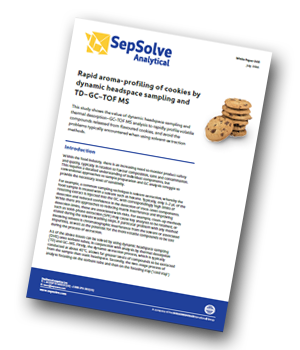SepSolve Analytical has produced an application note showing the value of dynamic headspace sampling and thermal desorption–GC–TOF MS analysis to rapidly profile volatile compounds released from flavoured cookies, and avoid the problems typically encountered when using solvent-extraction methods.
 Introduction
Introduction
Within the food industry, there is an increasing need to monitor product safety and quality, typically in relation to flavour composition, taint and contamination. This requires a detailed understanding of individual components, but conventional approaches to sample preparation and GC analysis struggle to provide the necessary level of sensitivity.
Dynamic headspace sampling (DHS) onto sorbent tubes, in conjunction with analysis by thermal desorption
(TD) and GC–MS offers an effective solution to this. Firstly, the dynamic extraction process, which is typically conducted at about 40 °C, allows far greater levels of compounds to be extracted from the sample than static headspace. Secondly, the two-stage process of analyte focusing on the sorbent tube and then on the focusing trap (‘cold trap’) within the TD instrument results in analytes being focused in a narrow band of vapour, greatly improving peak shape and detection limits.
Experimental
A Micro-Chamber/Thermal Extractor™ is used for simple dynamic headspace extraction onto sorbent tubes, followed by analysis of the tubes with a TD100-xr™ thermal desorber, GC separation, and
detection with a BenchTOF™ mass spectrometer.
Results and Discussion
Example analyses are shown at 40 °C and 80 °C of three types of cookies run at a split ratio of 100:1. Many compounds associated with flavours are identified, including a number of pyrazines, alcohols, aldehydes and ketones that may contribute to the aroma.
Conclusion
In this study, the combination of dynamic headspace sampling with TD–GC–TOF MS analysis is shown to offer efficient evaluation of volatile compounds from cookies, which avoids the disadvantages of solvent-based methods at the same time as enhancing sensitivity.
The TOF mass spectrometer also plays a key role in this analysis, by enabling flavour/aroma compounds to be identified with greater confidence through the generation of ‘reference-quality’ spectra.




